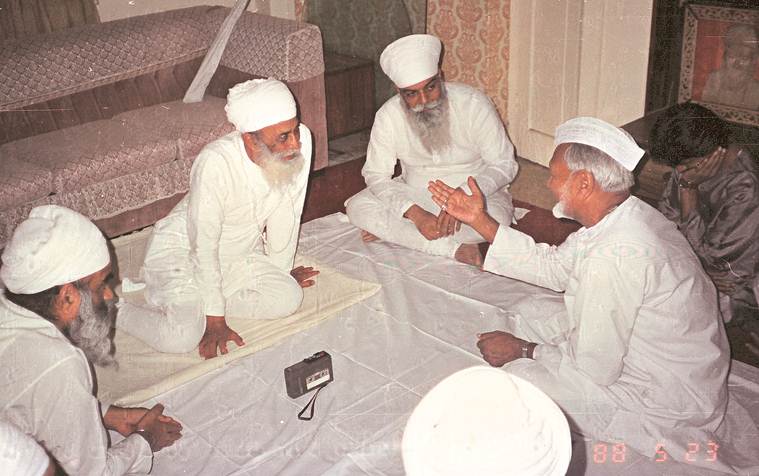Click here to follow Screen Digital on YouTube and stay updated with the latest from the world of cinema.
The Art of Listening
A documentary explores the legacy of the late Satguru Jagjit Singh Ji and the lasting relationship between the Namdhari Sikhs and Indian classical music
 The documentary begins with a brief history of the Namdhari Sikhs, especially of Satguru Partap Singh.
The documentary begins with a brief history of the Namdhari Sikhs, especially of Satguru Partap Singh.
We’d wrapped up a show in Hyderabad and we had a performance the next day in Aurangabad. The journey was by road and it was such a long one that our driver was falling asleep at the wheel. I decided to drive the car, and it took us several hours to reach the venue. When we reached, we saw the audience was already present, and we washed our faces and went on stage, and began playing. Oh, what an excellent show it was!” says Ustad Zakir Hussain, reminiscing about the first sangeet sammelans organised by the late Satguru Jagjit Singh (1920-2012) and the Namdhari Sikhs, back in the 1970s. Hussain had a flight to catch but there was no way the maestro was going to miss the premiere of Sangeet – Saroop – Satguru: A Music Journey of His Holiness Satguru Jagjit Singh Ji, held in Mumbai a little while ago. “Satguru Jagjit Singh Ji would conduct sessions where all the classical musicians of different gharanas would gather together. When he lived, it was a moment in time when art was supreme,” he adds.
Conceived by Taranjiet Singh Namdhari, nearly two decades ago, the documentary is a labour of love. “As a Namdhari, I was always aware that Satguru Jagjit Singh Ji was our religious leader but for the most part, I’d been trying to escape that side of my background. But in early 2000, I visited Bhaini Sahib (the village in Ludhiana district, which is the seat of the Namdhari Sikhs) for the first time as an adult. I wasn’t going through a great patch in my life and I wanted to connect with my roots. After I met him, I felt that I should make a documentary about him,” says Taranjiet, 48, who made a career for himself as an editor in Bollywood, working on films such as Mohabbatein and The Great Indian Escape, and designed visual promotions for blockbusters such as Dil Toh Pagal Hai and Kuch Kuch Hota Hai.
At Bhaini Sahib, he found a treasure trove — 8 mm and 16 mm films, a large number of audio cassettes dating back to the 1970s-80s — but with no way of knowing what was contained in those reels and tapes. “I went through them and saw that over the years, musicians such as Ustad Alla Rakha, Ustad Vilayat Khan and Pandit Ravi Shankar had travelled and performed at Bhaini Sahib. Satguru Ji’s foresight resulted in history being recorded. I started digitising whatever I could,” says Taranjeit, adding, “Watching those tapes, I realised that this was not just about performances, but something larger was at work here. In 2007, I decided that the documentary would be about the relationship between Satguruji, Bhaini Sahib and music.”
The documentary begins with a brief history of the Namdhari Sikhs, especially of Satguru Partap Singh. “The Gurbani is written in different raagas, and he brought singers and musicians to the village to learn how it should be sung. Satguru Jagjit Singh Ji was brought up in that environment,” says Taranjiet. When he became the spiritual leader of his people, Jagjit Singh Ji carried forward his father’s legacy and invited notable musicians to the village. “He understood that listening is learning, and that while music helped one practice discipline and focus, it was also a way to look inward. Post-Independence, there is no one who was a patron of Hindustani classical music in the way he was,” says Pandit Shiv Kumar Sharma in the documentary. Pandit Rajan and Sajan Mishra agree, they owe a great debt to Jagjit Singh Ji. “Panditji was working at the time, he was yet to become famous. Satguru Ji asked him to leave his job and gave him a monthly stipend so that he could focus on his craft. Later, Pandit Sajan Mishra joined his brother in Delhi from Varanasi. Soon after, they had their first performance on AIR,” says Taranjiet.
Throughout the two-hour-long documentary, musicians like Hussain, Sharma and Ustad Amjad Ali Khan mention how Jagjit Singh Ji was an accomplished singer and musician himself. “Especially dhrupad,” says Taranjeit, “it’s slow in tempo, one pays attention to the words, the cadence, in a way that khyal does not.” “He played the dilruba with such mastery, in a way that was unique to him,” said Sharma at the premiere.
Taranjiet hopes to do a limited release of the film in cinemas in Punjab, Haryana and Himachal Pradesh. “Those are the places where most people will know about the history of Satguru Ji. We’ve also done a five-part series, each is 55 minutes long, from the film and we hope to release it online in October. In addition, the musicians featured in the documentary will be screening the film at their respective institutions, starting with the Ustad Alla Rakha Institute of Music in Mumbai,” says Taranjeit.




- 01
- 02
- 03
- 04
- 05





























